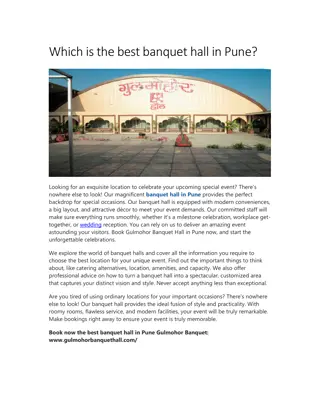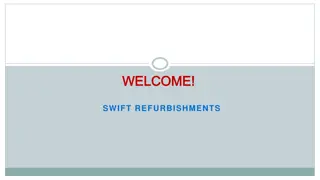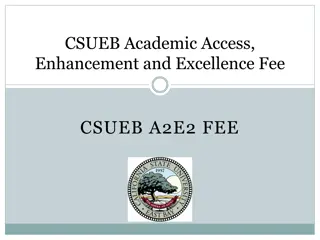Leveraging Blogs for Course Enhancement by Leigh A. Hall
Associate Professor Leigh A. Hall explores the benefits of using blogs in educational settings to enhance student interactivity, disrupt traditional learning methods, and empower students through knowledge sharing and ownership. The study delves into the setup, management, and impact of blogging in a classroom environment, shedding light on the transformative potential of this digital tool.
Uploaded on Oct 02, 2024 | 0 Views
Download Presentation

Please find below an Image/Link to download the presentation.
The content on the website is provided AS IS for your information and personal use only. It may not be sold, licensed, or shared on other websites without obtaining consent from the author.If you encounter any issues during the download, it is possible that the publisher has removed the file from their server.
You are allowed to download the files provided on this website for personal or commercial use, subject to the condition that they are used lawfully. All files are the property of their respective owners.
The content on the website is provided AS IS for your information and personal use only. It may not be sold, licensed, or shared on other websites without obtaining consent from the author.
E N D
Presentation Transcript
Using Blogs for Course Assignments Leigh A. Hall Associate Professor of Literacy Studies School of Education lahall@email.unc.edu
Thank You! The work presented today was made possible by a generous grant from the Center for Faculty Excellence and Lenovo
Presentation Overview Study Overview Blog set-up and management What to expect when you ask your students to blog
Why Blog? Increases interactivity and connectivity Disrupts positions Makes knowledge and knowledge development public Can help students take more ownership of their learning
Empowering & Disrupting Empowerment can occur when students: are given control over issues important to them can influence actions and are given the opportunity to make change Empowerment can fluctuate One path to empowerment is through disrupting everyday practices of learning and engaging with ideas
Guiding Questions How do teachers use blogging to: address/solve problems? examine ideas relevant to the course and/or their practice? How do teachers interact with each other in the blogosphere?
Study Design Formative design lasting one academic year Pedagogical Goals: We wanted teachers to use their blogs as a space for (a) examining connections between classroom practice and course content (b) evaluating and analyzing ideas presented through the course or by their colleagues (c) sharing and discussing problems of practice.
Setting & Participants 26 teachers enrolled in a Masters program 85% taught K-5. Teachers were comfortable with using computers and learning new technology No one had prior experience with blogging
Data Sources Blogs (total) 602 blog posts 890 comments Interviews Five teachers were interviewed twice (November/April)
Blogging Procedures Blog once a week for 11 weeks each semester (22 weeks total) Make two comments each week for 10 weeks (20 weeks total) Blog topics: (a) Fall: Teachers could blog about anything related to literacy (b) Spring: Teachers needed to restrict blogging to topics related to content area literacy
Fall Blogs 301 posts made/average of 11.57 posts per teacher. 445 out of 520 (85%) comments/ average 20 per teacher
Data Analysis Descriptive codes that offered explanations for the pedagogical goals were first identified Single pattern codes that best captured overall themes were created Assertions were then determined from the pattern codes.
Blogging to Reinforce Beliefs Teachers spent little time investigating or questioning their beliefs and or teaching practices. Instead, they used the blog as a place to discuss what they believed and justified it.
Blogging to Reinforce Beliefs ESL Reinforce Beliefs Labeling Examine Beliefs GFI 0% 50% 100%
Blogging to Reinforce Beliefs I feel like there is so much more I could do to help my ELLs. When reading books, I try to use as many pictures for the vocabulary words as I can. Even though my students speak English, I have noticed that vocabulary is challenging for them at times. Amanda, First Grade Teacher Differentiation sounds fabulous. It truly does. It s the way things should be. Each child should work on his/her personal level and teachers should challenge them just enough- but not too much. But HOW? My kids are all so different! The classroom teacher (no matter how much we want to, or how hard we try) simply cannot do it all. -Kristine, Kindergarten Teacher
Platform for Addressing Problems Teachers Do Not Use the Blog to: Teachers Use the Blog to: Layout the problem and present their side of the issue Collaborate on solutions to problems Report back regarding progress made on the problem Invite others to engage with them around the problem
Platform for Addressing Problems Inviting Teachers to Engage Around Problems RF 30% STE 32% Ask ? 38% STE: Struggles Teachers Encounter RF: Requests Feedback Ask ?: Asks a Question
Platforms for Addressing Problems Cherie on implementing Daily 5 for the first time: I feel that after the morning block, [students] really don t have that much of an opportunity to read. Is it like this at your school? What do you do when there is a specific time scheduled for you? What other things can you do in the classroom to make sure they have other opportunities [to read]?
Finding: Teachers use comments to affirm/agree but not to question or challenge. Fall Affirm/Agree Compliment Asks Question Support 0% 20% 40% 60% 80% 100%
Finding: Teachers use comments to affirm/agree but not to question or challenge. Affirm/Agree: I think this unit on schema does a great job of addressing and explicitly teaching 21st century skills. Compliment: I absolutely love these resources! Keep sharing! Asks a Question: How did you come up with the idea for an all boys book club? Offers Support: I think if you thought of creative prompts they may enjoy responding to their reading. Their manners of responding could involve writing, drawing, and maybe another medium
Implications Students will likely need help: (a) to critically engage with the information/ideas and with each other (b) using comments well (c) return/revisit ideas
Blog Set-Up and Management Expectations Blogosphere Etiquette How many posts/comments per week? Content Management How to keep track of blogs Giving feedback on blogs Staying connected with your students
How to Implement Blogging: The Basics Establish a place for the blogs. Blogs can be implemented on public sites (wordpress), private, password protected sites (available through ning.com), or sites intended for educators (edublogs). Decide how often you want students to blog. In a semester course, we require blogging to occur for 10/12 weeks. Studentss can take any two weeks off. We do not allow make-ups. Do you want students to comment on blogs? We ask them to comment at least twice a week on the posts of others. How do you keep up with all this? See our handout that shows how we track blog posts and comments. What topics are acceptable in blogging? Provide students with a set of guidelines about what they can write about. Discuss what makes a good comment (and a good blog post). See our handout for guidelines we provide to students.
Documenting Your Blog Work Date #1 (8/27-9/2) #2 (9/3-9/9) #3 (9/10-9/16) #4 (9/17-9/23) #5 (9/24-9/30) #6 (10/1-10/7) #7 (10/8-10/14) #8 (10/15-10/21) #9 (10/22-10/28) #10 (10/29-11/4) #11 (11/5-11/11) #12 (11/12-11/18) #13 (11/19-11/25) #14 (11/26-12/2) Post? Skipped?
Tracking Comments Date #1 (8/27-9/2) #2 (9/3-9/9) #3 (9/10-9/16) #4 (9/17-9/23) #5 (9/24-9/30) #6 (10/1-10/7) #7 (10/8-10/14) #8 (10/15-10/21) #9 (10/22-10/28) #10 (10/29-11/4) #11 (11/5-11/11) #12 (11/12-11/18) #13 (11/19-11/25) #14 (11/26-12/2) Comment #1 Comment #2 Skipped?
What Makes a Good Blog Post? Have a purpose. Your post cannot talk about everything. Know you may have to leave interesting things out. Save those interesting things for a different blog post. It's better to have a clear, focused post than a list of random interesting things. Remember your audience. Yes, you are a part of this class and program. However, your audience is not solely this class. When you write a post, add information that will help your audience be able to understand you. Read the blogs of members who are not in this class. Find the ones you like. Use them as a model. Craft an interesting title. While this last tip is not always possible, it is a good one to keep in mind. At the very least, try to write a title that captures the overall point of your post. It will help orient your readers so they know what to expect.
What Makes a Good Comment? It's easy to write a comment that praises a person. However, good comments will push the writer to think more deeply about their ideas. Keep the following in mind: 1. If you praise someone, do more than say, "I like that!" or "Great idea!" Tell the author specifically what you like. 2. Leave a question or thought behind that pushes the author to think more about the post. For example, "I really like that you let the students choose their own books to read. However, I am wondering how you might get students to pick books in genres they are less familiar with." 3. Make a suggestion. If the author is sharing an issue or concern, offer specific ideas for how to address it. 4. Pay attention to previous comments. When relevant, make connections to what other commenters have said. You are having a discussion with the author but also other commenters.
What Do You Do With Comments? The answer is, "It depends." In general, you want to acknowledge 90% or more of the comments that are left for you. Acknowledging comments is not required for this class. However, in blogging it is considered good manners to do so. It is also considered good form to read that person's blog and leave a comment when it is appropriate. Not all comments will be substantive. You do not need to respond to comments that do little more than say, "Great post," or you can acknowledge them in one sweeping response such as, "Thanks for the support! So glad everyone enjoyed this." The people who deserve a response are the ones who put thought and effort into their comment regardless of the length of the comment.
Blogging support at Carolina Campus blogging platform (Wordpress) web.unc.edu Developing blog assignments Center for Faculty Excellence























